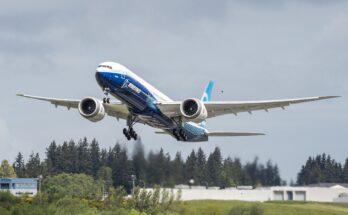
Yakovlev, formerly known as Irkut, recently carried out the first flight of a new version of the Superjet 100 regional airliner that features domestically produced systems and components. Redesignated the SJ-100, the new model will allow Yakovlev to continue to produce the regional jet despite an embargo on foreign-sourced components imposed by the U.S. and the European Union after Russia began its “special military operation” in Ukraine in 2022.
Rostec, the corporate parent of Yakovlev and a range of other state-owned aerospace and defense companies in Russia, reported that the test flight went smoothly.
The first SJ-100 prototype is powered by the Superjet 100’s existing PowerJet SaM146 engine, but Yakovlev plans to install Russian-made Aviadvigatel PD-8 turbofans on the second test aircraft and future production aircraft. The PD-8 is still in development and undergoing testing.
Rostec says it is sourcing 40 new components from Russian manufacturers, including a new avionics system, landing gear, an auxiliary power unit, and air conditioning systems, among others.
The full story is available on FlightGlobal at this link.
We expect deliveries of the SJ-100 to Russian airlines to start around 2025, but the in-service date will move to the right depending on how many technical issues turn up during the flight test program. The certification process by the Russian government is unlikely to be strict; the country needs a new version of the Superjet now that the supply of parts and maintenance services by Western manufacturers has been cut off. And we don’t expect the SJ-100 to be produced in large numbers – the Russian airline industry is relatively small. However, regional airline service remains a critical part of the Russian transport system. The Putin regime has no choice but to continue to support the program.
Forecast International’s Civil Aircraft Forecast covers the rivalry between Airbus and Boeing in the large airliner sector; the emergence of new players in the regional aircraft segment looking to compete with Bombardier, Embraer, and ATR; and the shifting dynamics within the business jet market as aircraft such as the Bombardier Global 7000, Cessna Hemisphere, and Gulfstream G600 enter service. Also detailed in this service are the various market factors propelling the general aviation/utility segment as Textron Aviation, Cirrus, Diamond, Piper, and a host of others battle for sales and market share. An annual subscription includes more than 70 individual reports, most with a 10-year unit production forecast. Click here to learn more.
A lifelong aviation enthusiast, Douglas Royce is currently co-editor of four of Forecast International's Market Intelligence Services: Civil Aircraft Forecast, Military Aircraft Forecast, Rotorcraft Forecast, and Aviation Gas Turbine Forecast. As such, he plays a key role in many important projects that involve market sizing and forecasting for various segments of the world aerospace industry, as well as demand for related systems.




